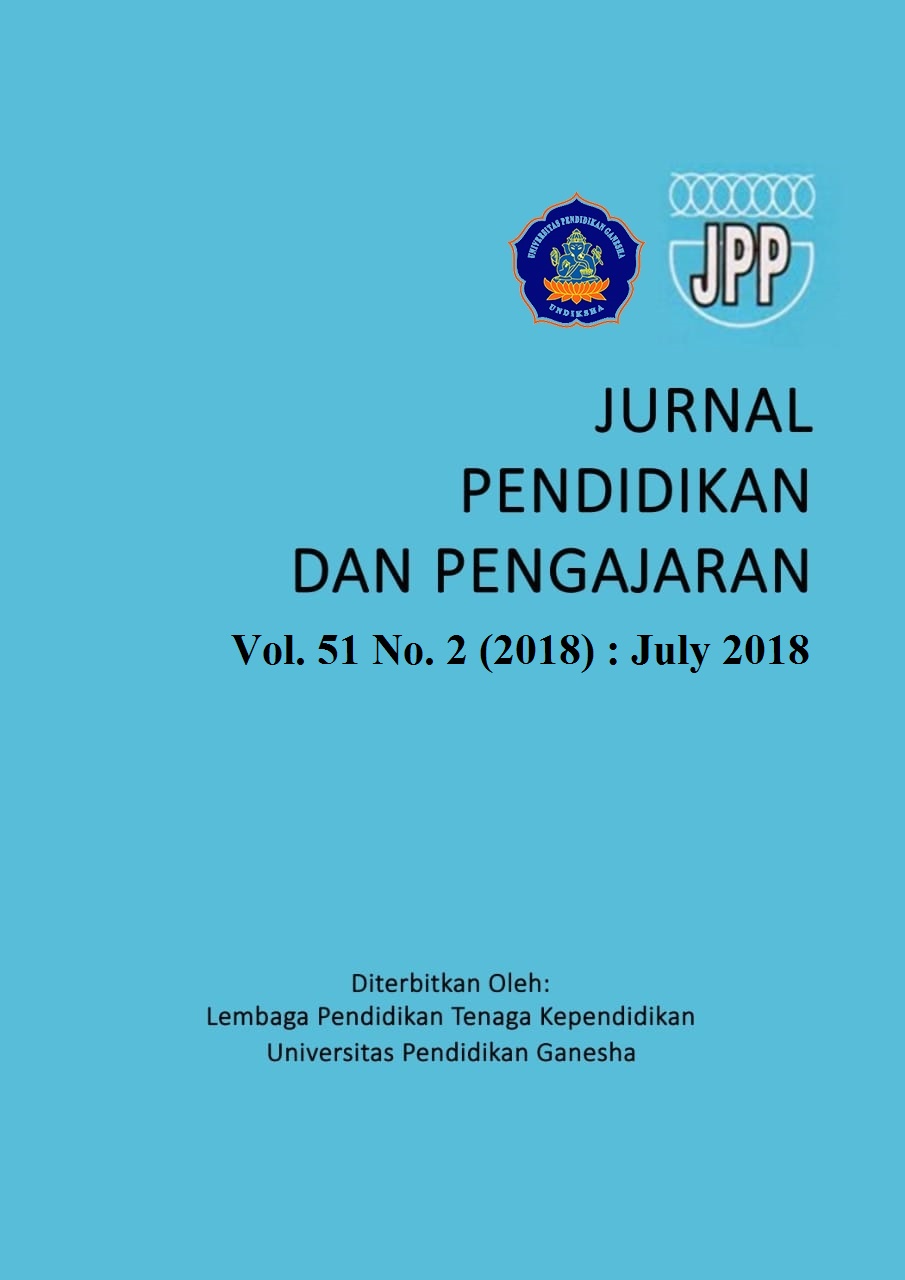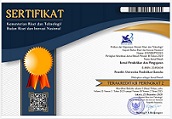DEVELOPMENT OF PROJECT BASED BLENDED LEARNING (PjB2L) MODEL TO INCREASE PRE-SERVICE PRIMARY TEACHER CREATIVITY
DOI:
https://doi.org/10.23887/jpp.v51i2.12795Keywords:
learning model, project based blended learning, students’ creativity, lesson planAbstract
This research aims to develop project based blended learning model to grow pre-service primary teacher students’ creativity in designing lesson plan. This research was conducted due to the increasing needs in the 21st century. The method used in this research was R&D with ASSURE development model consisting of six stages. Product validation was done through an expert’s assessment by using the expert’s validation sheet. Product effectiveness was seen by implementing limited development testing to a particular class with a one group pretest-posttest design and the result was analyzed by using a Paired-Samples T-Test. The result of this research was in the form of a creative learning model based on project-based learning and blended learning to increase the creativity of pre-service primary teacher college students in designing a lesson plan. Validity of the learning model was proven by the result of the expert assessment in learning (face-to-face and on-line), material and instructional media. Effectiveness of the learning model was also proven on the basis of Paired-Samples T-Test of students’ pretest and posttest.
References
Anastasiya Vyacheslavovna Krinistsyna, e. a. (2016). Characteristics of the Creative Development technologies Applying During the Work with Students. International Journal of Enviromental & Science Education, 11 NO. 18, 11709-11720.
Boelens, R., Wever B.D. & Voet, M. (2017). Four key challenges to the design of blended learning: A systematic literature review. Educational Research Review, Vol.22. November 2017, 1-18
Charles D. Dziuban (2004). Blended Learning. Central Florida: EDUCAUSE Center for Applied Research Volume 2004, Issue 7.
Dangwal, L. &. (2017). Blended Learning: An Innovative Approach. Universal Journal of Educational Researh, 5 no. 1, 129-136. doi:10.13189/ujer.2017.050116
Dick & Carey. 2005. The systematic Design of Instruction sixth Edition. Amerika: Allyn and Bacon
Ergul, N.R., Kargin, E.K. 2014. The Effect of Project based Learning on Students’ Science Success. Procedia – Social and Behavioral Sciences, 136, 537-541.
Giacomini, L. (2015). Using "Storybird" in Young Learners' Creative Writing Class. Teaching Technique: English Teaching Forum, 35-37.
Guven, T. K. (2014). The Effec of Project Based Learning on the Statistical Literacy Levels of Students 8th Grade. European Journal of Educational Research, 3 No. 3, 145-157. Retrieved from http://www.eurojedu.com
Han, S., Capraro, R., Capraro, M. 2016. How science, technology, engineering, and mathematics project based learning affects high-need students in the US. Learning and Individual Differences, 51, 157-166.
Henriksen, Danah. (2016). The seven transdisciplinary habits of minds of creative teachers: An exploratory studi of award winning teachers. Teaching Skills and Creativity, Vol 22 December 2016, Pages 212-232. https://doi.org/10.1016/j.tsc.2016.10.007
Hsieh, S.W., et.al. (2011). Effects of teaching and learning styles on students’ reflection levels for ubiquitous learning. Computers & Education, Volume 57, Issue 1, August 2011, Pages 1194-1201. https://doi.org/10.1016/j.compedu.2011.01.004
Jared A. Carman, (2005). Blended Learning Design: Five Key Ingredients. Diambil dari http://www.agilantlearning.com/pdf/Blended Learning Design.pdf diunduh, 25 Oktober 2012.
Joao Alberto Arantes do Amaral, e. a. (2015). Creating a Project-Based Learning Enviroment to Improve Project Management Skills of raduate Students. Journal of Problem Based Learning, 3, No,2, 120-130. Retrieved from http://dx.doi.org/10.5278/ojs.jpblhe.v0i0.1178
Krinistsyna, Anastasiya Vyacheslavovna, e. a. (2016). Characteristics of the Creative Development technologies Applying During the Work with Students. International Journal of Enviromental & Science Education, 11 NO. 18, 11709-11720.
Larmer, J. & Mergendoller, J. R., 2012. 8 Essentials for Project-Based Learning.
Liu, P. (2016). Technology Integration in Elementary Classrooms: Teaching Practices of Student Teachers. Australian Journal of Teacher Education, 41(3), 87-104.
Maryland Online Inc. (2011). Quality Matters Rubric Standards 2011-2013 Edition. Diunduh pada tanggal 24 Februari 2013, dari Quality Matters Program: http://www.qmprogram.org/files/QM_Standards_2011-2013.pdf
Morais, Maria Fatima & Azevedo, Ivete. (2011). What is a Creative Tecaher and What is a Creative Pupil? Perceptions of Teachers. Procedia Social and Behavioral Sciences, Vol 12, 2011, Page 330-339, https://doi.org/10.1016/j.sbspro.2011.02.042
Nursafa Khairullina, e. a. (2016). Development of Creative Activity os Students in the System of the Organizational Culture of the Modern University. International Journal of Enviromental & Science Education, 11 No.4, 2171-2184. doi:10.12973/ijese.2016.588a
Odhiambo, N. W. (2016). Project Based Learning on Students' Performance in the Concept of Classification of Organism Among Secondary Schools in Kenya. Journal of Education and Practice, 7 No. 16, 25-31. Retrieved from www.iiste.org
Powel, A., et.al. (2015, July). Blending Learning: The Evolution of Online and Face-toFace Education from 2008-2015. iNACOL, 1-20.
Richardson, C & Mishra, P. 2017. Learning environments that support student creativity: Developing the SCALE. Thinking Skills and Creativity, 27, 45-54.
Smaldino, S.E,Russel, J.D. Heinich, R. & Molenda, M. 2005. Intructional Technology and Media for Learning . New Jersey : Pearson Merril Prentice Hall Inc
Soh, K. 2017. Fostering student creativity through teacher behaviors. Thinking Skills and Creativity, 23, 58-66.
Standberg, A. G. (2014, October). Online Teaching Best Practice to Better Engage Students with Quantitative Material. Journal of Instructional Pedagogies, 15, 1-14. Retrieved from http://www.aabri.com/copyright.html
Stix, A. & Hrbek, F., 2007. Guru sebagai Pelatih Kelas. Jakarta: Erlangga.
Suharsimi Arikunto. (2003). Dasar-dasar evaluasi pendidikan (Edisi Revisi). Jakarta: PT Bumi Aksara.
Tsai, C.Y., Horng, JS, Liu, CH, Hu, DC, Chung YC. (2015). Awakening student creativity: Empirical evidence in a learning environment context. Journal of Hospitality, Leisure, Sport & Tourism Education, 17, 28-38.
Tylek, J. S. (2012). Systemwide Impementation of Project-Based Learning. 1-8.
Udin S. Winataputra (2001). Model-model Pembelajaran Inovatif. Jakarta : Pusat Antar Universitas untuk Peningkatan dan Pengembangan Aktivitas Instruksional, Dirjen Dikti
Vastenhouw, M., 1982. Metode Pengajaran Proyek. s.l.:Keluarga Mahasiswa BAPEMSI
Widiana, I Wayan, I. N. (2016, September). Improving Students' Creative Thinking and Achievement through the Implementation of Multiple Intelligence Approach with Mind Mapping. International Journal of Evaluation and Research in Education, 5 No. 3, 246-254.
Zaouganeli, E., Tysso, V., Feng, B., Arneses, K., Kapetanovic, N. 2014. Projrct-based learning in programming classes – the effect of open projrct scope on student motivation and learning outcome. IFAC Proceedings Volumes, 47, 12232-12236.
Downloads
Published
How to Cite
Issue
Section
License
Authors who publish with Jurnal Pendidikan dan Pengajaran agree to the following terms:- Authors retain copyright and grant the journal the right of first publication with the work simultaneously licensed under a Creative Commons Attribution License (CC BY-SA 4.0) that allows others to share the work with an acknowledgment of the work's authorship and initial publication in this journal
- Authors are able to enter into separate, additional contractual arrangements for the non-exclusive distribution of the journal's published version of the work (e.g., post it to an institutional repository or publish it in a book), with an acknowledgment of its initial publication in this journal.
- Authors are permitted and encouraged to post their work online (e.g., in institutional repositories or on their website) prior to and during the submission process, as it can lead to productive exchanges, as well as earlier and greater citation of published work. (See The Effect of Open Access)





